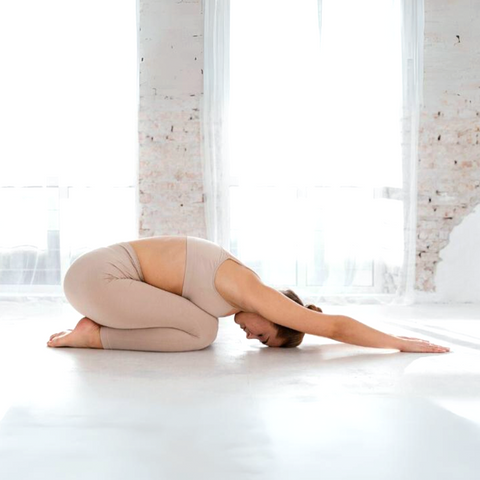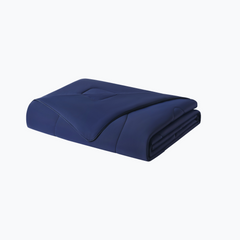Adult Bedtime Routine for Better Sleep
Guide to Nightly Routines for Improving Sleep
Creating and maintaining a bedtime routine and enhancing your sleep environment is crucial for improving sleep quality, which in turn helps overall health and well-being. A good night's rest supports cognitive function, mood, as well as both mental and physical health.

We’ve compiled some common do’s and dont’s that could affect your ability to fall asleep, as well as tips on how to achieve high-quality sleep. We’ll also look into how bedding that regulates body temperature can impact sleep and why it shouldn’t be overlooked.
How to Establish a Bedtime Routine for Better Sleep
A consistent bedtime routine can help signal to your body that it's time to wind down and prepare for sleep. Activities that promote relaxation and decrease stress can significantly help you fall asleep faster for longer and yield higher quality rest. As consistency is key, slowly adding a new habit over a longer period can make it easier to adopt, ultimately leading to better, healthier sleep hygiene.
Is it Okay to Eat and Drink Before Bed?
Be mindful of what and when you eat and drink before bed as it can significantly affect your sleep quality:
- Researchers suggest, “earlier timing of eating or drinking in relation to bedtime – between 4 and 6 hours – increases the likelihood of optimal sleep duration.” They also found that food consumption too close to bedtime increased the odds of ‘wake after sleep onset’ (WASO), meaning an interrupted sleep period and a key symptom of chronic insomnia.
- Heavy meals and spicy foods can cause discomfort and should be avoided prior to bedtime.
- Limit caffeine and alcohol intake: Caffeine can keep you awake, while alcohol, though initially sedating, can disrupt your sleep cycle later in the night due to the rebound effect.
Should I Limit Screen Time Before Bed?
Device use should absolutely be minimized before bedtime. Electronic devices like smartphones, tablets, and televisions emit blue light waves, which can interfere with the production of the sleep hormone melatonin. To ensure better sleep quality:
- Avoid screen time at least an hour before bed time. We’re often using our devices throughout the day, but screen time should be especially restricted to decrease blue light exposure before sleeping. Blue light waves are visible light that helps us stay alert, so avoiding it can allow your body's natural sleep processes, also known as circadian rhythm, to begin.
- Use blue light filters if avoiding screens isn't possible. Most device settings and screens can be configured to have a “Night Shift” mode that helps minimize the blue light emitted and eye strains. Another alternative is blue light-blocking glasses to reduce blue light exposure at night.

Does Reading Before Bedtime Affect your Sleep?
Engaging in light reading can help your mind transition from the day's stresses to a state of relaxation. In one research trial, participants found reading a book before going to sleep improved sleep quality. That said, choose materials that are calming and not overly stimulating (probably best to skip a page-turner novel).
Does a Warm Bath or Shower Help with Sleep?
A warm bath or shower does help with sleep, but not how we think it would. Researchers suggest that a warm bath or shower increases your body's temperature slightly, but then the opposite occurs: you’ll experience a subsequent drop in body temperature which actually stimulates the feeling of sleepiness as your body cools down.
So when should you take a bath or shower before bed to reap these benefits? The study suggested that taking a bath or shower one to two hours before falling asleep will improve sleep quality and increase the overall amount of time slept.
Does Meditation and Yoga Help with Sleep?
Relaxation techniques like mindfulness meditation practices and yoga can significantly improve sleep quality by reducing stress and anxiety. These mind-calming exercises can help focus on breathing and awareness of the present moment rather than stressing about the past or future.
A study published in JAMA Internal Medicine found meditating before bed resulted in less insomnia, fatigue and depression. Simple 20-minute meditation sessions can help calm the mind and prepare your body for sleep.
How to Meditate Before Bed?
- Prepare Your Space: Find a quiet, comfortable spot where you won't be interrupted and sit or lie in a comfortable position while maintaining a straight back.
- Focus on Breathing: A technique to get started is to close your eyes and breathe deeply, inhaling through the nose and exhaling through the mouth. Keep your focus on the sensation of breathing. Gently return your attention to your breathing whenever your mind wanders.
- Observe Without Judgment: Begin practicing mindfulness by noticing your thoughts, feelings, and bodily sensations, observing them without criticism. Begin with 5 minutes and gradually extend the time as you get more comfortable.
Once you are ready, gently open your eyes and stretch if necessary, taking a moment to notice how you feel. To learn more about meditation styles and guides, visit here.
Bedtime Yoga Routine For Better Sleep
Yoga is another widely practiced relaxation and mindfulness technique that has been praised for helping with sleep. A survey found over 55% of people who did yoga reported improved sleep from practicing it. Yoga helps calm the mind, relieve tension in the body, and prepare you for restful sleep. Here’s a simple yoga routine designed to relax your body and mind:
Child's Pose (Balasana)
- Kneel on your mat with your knees wide apart and your toes touching. Exhale as you lower your torso between your knees, extending your arms forward on the floor, palms down. Rest your forehead on the mat.
- Relieves stress and tension in the back, shoulders, and chest. Encourages a sense of calm and stability.
Legs-Up-The-Wall Pose (Viparita Karani)
- Sit with your right side against a wall, then gently turn to the left and lift your legs up to rest against the wall, lying back and keeping your bottom as close to the wall as comfortable. Rest your arms in a comfortable position by your side.
- Helps relax the mind and body, relieves tired legs, and can help with mild backache.
 |
 |
Seated Forward Bend (Paschimottanasana)
- Sit up with your legs stretched out in front of you. Inhale and lengthen your spine as if a string abovehead is pulling you up. As you exhale, gently fold forward from the hips, reaching for your toes or legs, whatever feels comfortable without straining.
- Calms the brain, relieves stress, stretches the spine, shoulders, and hamstrings.
Supine Twist (Supta Matsyendrasana)
- Lie on your back and bring your knees to your chest. Extend your arms out to the sides, then slowly drop your knees to one side while turning your head to the opposite side.
- Releases tension in the lower back, stretches the back muscles and glutes, and relaxes the body.
 |
 |
Corpse Pose (Savasana)
-
Lie flat on your back, legs slightly apart, and arms relaxed at your sides, palms facing up. Close your eyes and take deep, slow breaths. Allow your body to feel heavy and sink into the mat. Stay in this pose for 5-10 minutes.
-
Promotes deep relaxation and stress relief, allowing the body to prepare for sleep.
Tips for Bedtime Yoga Routines
- Keep it Gentle: Focus on slow, gentle movements to calm the nervous system.
- Focus on Breathing: Use deep, slow breaths to enhance relaxation.
- Listen to Your Body: Don’t push into painful positions. Comfort is key to relaxation.
- Create a Calming Environment: Dim the lights, play soft music, or use essential oils to enhance relaxation.
Incorporating this routine into your nightly regimen can help ease the transition into sleep, making for a more restful night. Remember, the goal is relaxation, so move through each pose with mindfulness and ease. Depending on your skill level, many tutorials are available online with varied poses that can contribute to relieving stress and tension at the end of the night.
Does Bedding Affect or Improve Sleep?
We often splurge and invest in high quality mattresses and pillows in hopes of getting better sleep, but often overlook comforters or duvets and sheets, which can cause noticeable improvements. Beyond merely serving as a decorative element, the right bedding can play a pivotal role in enhancing sleep quality.

How Bedding Contributes to Temperature Regulation for Better Sleep
Thermal environments are one of the most important factors that can affect sleep, highlighting how your bedding material plays a crucial role in maintaining a restful sleeping experience. Excessive heat can disrupt sleep stages, leading to restlessness and awakenings. The right materials can help regulate body temperature by allowing air circulation and prevent excessive heat accumulation, ensuring a comfortable sleep regardless of the season.
This is particularly true with Evercool®, our proprietary fabric innovation which boasts one of the highest lab tested Q-max value, a measure of how effective a material can regulate your body temperature. The Evercool® Cooling Comforter is one of the best cooling comforters for hot sleepers and even helps with moisture wicking to minimize night sweats.
Bedding can Enhance Comfort and Support
The comfort provided by your bedding can significantly affect how well you sleep. High-quality sheets and blankets that feel soft against the skin can enhance sleep comfort and reduce the time it takes to fall asleep. Crafted from an ultra-fine yarn that emulates silk proteins, our Evercool® Sheet Sets are unbelievably soft and refreshingly cool so you’ll always have the cold side of the pillow, night after night.
Why You Need Sheets and Fabrics with Hypoallergenic Properties
For those prone to allergies, hypoallergenic bedding is a game-changer. Materials like silk and certain tightly woven fabrics can repel dust mites, mold, and other allergens, reducing sneezing, itching, and other allergic reactions that can disrupt sleep. Opting for hypoallergenic bedding can lead to a cleaner, healthier sleep environment.
Our Evercool® fabric takes it one step further with IONIC+™ Antimicrobial Tech, which utilizes positively charged silver ions to combat microbes and odor-producing bacteria - preventing its growth to keep the fabric fresher, cleaner and lasting longer.
How to Choose the Right Bedding
- Material Matters: Select breathable fabrics for sheets, pillowcases and bedding to enhance comfort and temperature regulation.
- Invest in Quality: High-quality bedding may come with a higher price tag, but the investment pays off in durability and most importantly, sleep quality.
- Consider Your Needs: Whether it’s the softness of the fabric, its thermal properties, or hypoallergenic characteristics, choose bedding that meets your specific needs.





